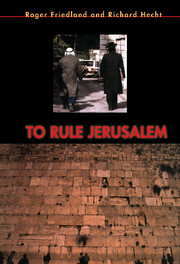Introduction
Published online by Cambridge University Press: 13 May 2010
Summary
In Jerusalem, Israelis and Palestinians must confront each other, and the faithful must deal with those who do not believe. Its neighborhoods are divided among rival nations and religions. Although their residents may ride the same buses and walk the same streets, buy and sell from one another, draw their water and electricity from the same sources, they all strive to insulate themselves from those who live differently. Each community is enclosed within its separate spaces, inhabited by those who order the world in the same way.
Contacts between communities must be carefully managed. The most uncomfortable encounters are often among kinsmen, within Jewish and Arab communities, not between them. Blood enemies evoke a mutual invisibility, fear, or hatred when one oversteps accepted boundaries. But fellow Jews and Arabs who violate the deeply felt commitments of their kinsmen are more likely to elicit disdain and anger.
On her way downtown, for example, a young Israeli woman takes a shortcut through an unfamiliar Jerusalem street. The hamsin, hot desert winds that will sweep the midday streets clean of people, are blowing from the east. She is wearing a t-shirt, blue denim skirt, and open leather sandals; her skin is the color of burnished leather; and one can just make out a flowered pattern on her brassiere.
Orthodox Jewish men in their late teens and early twenties stand around, cloaked in black. Their skins, alabaster from study, glisten with sweat. Side curls dangling, they hiss as the woman passes. One spits at her feet. Averting her eyes, she clutches her purse, hurrying to regain modern ground.
- Type
- Chapter
- Information
- To Rule Jerusalem , pp. 1 - 14Publisher: Cambridge University PressPrint publication year: 1996
- 1
- Cited by

